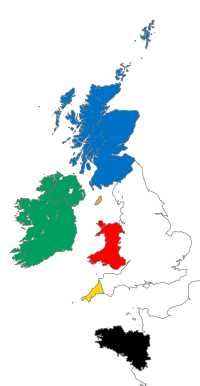凱爾特地區

凱爾特地區(英語:Celtic nations)是位於北歐及西歐的一系列地區的並稱。這一地區在過去或現在仍然使用凱爾特語,並在藝術、歷史、音樂、舞蹈、文學等文化領域擁有共通的獨特之處[1]。凱爾特地區包括了6個地區,分別是布列塔尼(Breizh)、康沃爾郡(Kernow)、愛爾蘭( Éire)、曼島(Mannin)、蘇格蘭(Alba)、威爾士(Cymru)[1][2]。這些地區至今仍然使用凱爾特語族的語言,或至現代為止都曾使用凱爾特語系語言[3]。除此之外,西班牙西北部(加利西亞、阿斯圖里亞斯、坎塔布里亞),葡萄牙(和加利西亞接壤山區的部分地區)有時也被認為屬於凱爾特地區[4][5][6]。在古羅馬和日耳曼尼亞文化圈擴大之前,凱爾特文化在歐洲文化中佔有重要的地位[7]。凱爾特地區現在的總人口有18,584,000人,其中能使用凱爾特系語言諸語的人口約有2,882,100人。近年在凱爾特地區,能使用凱爾特語言的人口有所增加[8][9]。
| 國家 (凱爾特名) |
凱爾特語 | 民族 | 人口 | 語言使用人數 | 語言使用比例 |
|---|---|---|---|---|---|
Éire |
愛爾蘭語 (Gaeilge) |
愛爾蘭人 (Éireannaigh, Gaeil) |
4,588,252[10] | 1,904,958[11][12] | 38.6% |
Tuaisceart Éireann |
愛爾蘭語 (Gaeilge) |
愛爾蘭人 (Éireannaigh, Gaeil) |
1,810,863[10] | 130,521[11][12] | 7.2% |
Alba |
蘇格蘭蓋爾語 (Gàidhlig) |
蘇格蘭人 (Albannaich) |
5,313,600 | 92,400[13] | 1.2%[14] |
Mannin Ellan Vannin |
曼島語 (Gaelg) |
曼島人 (Manninee) |
84,497[15] | 1,662[15] | 2.0%[15] |
| 威爾斯語 (Cymraeg) |
威爾斯人 (Cymry) |
3,000,000 | 750,000+: 威爾斯:611,000[16] 英格蘭:150,000 [17] 阿根廷:5,000[18] 美國:2,500 [19] 加拿大:2,200 [20] |
21.7%[21] | |
| 康瓦爾語 (Kernowek) |
康瓦爾人 (Kernowyon) |
500,000 | 2,000[22] | 0.1%[23][24] | |
Breizh |
布列塔尼語 (brezhoneg) |
布列塔尼人 (Breizhiz) |
4,300,000 | 206,000[25] | 5%[25] |
參考資料
- ^ 1.0 1.1 Koch, John. Celtic Culture : A Historical Encyclopedia. ABL-CIO. 2005: xx, 300, 421, 495, 512, 583, 985 [24 November 2011]. ISBN 978-1-85109-440-0.
- ^ Celticleague.net. [2013-11-18]. (原始内容存档于2009-10-08).
- ^ Koch, John T. Celtic Culture: A Historical Encyclopedia. ABC-CLIO. 2006: 365 [2 March 2011]. (原始内容存档于2013-10-23).
- ^ Koch, John T. Celtic Culture: A Historical Encyclopedia. ABC-CLIO. 2006: 365, 697, 788–791 [2 March 2011]. (原始内容存档于2013-10-23).
- ^ Alberro, Manuel. Celtic Legacy in Galicia. E-Keltoi: Journal of Interdisciplinary Celtic Studies. 2005, 6: 1005–1035 [2013-11-18]. (原始内容存档于2013-06-01).
- ^ Site Officiel du Festival Interceltique de Lorient. Festival Interceltique de Lorient website. Festival Interceltique de Lorient. 2009 [2009-05-15]. (原始内容存档于2010-03-05).
- ^ Ian Johnston. We're nearly all Celts under the skin. The Scotsman. 21 September 2006 [2007-11-24]. (原始内容存档于2007-12-12).
- ^ Fockle ny ghaa: schoolchildren take charge. [2014-05-10]. (原始内容存档于2009-07-04).
- ^ 'South West:TeachingEnglish:British Council:BBC. BBC/British Council website (BBC). 2010 [2010-02-09]. (原始内容存档于2013-02-11).
- ^ 10.0 10.1 The 2011 population of the Republic of Ireland was 4,588,252 and that of Northern Ireland in 2011 was 1,810,863. These are Census data from the official governmental statistics agencies in the respective jurisdictions:
- Central Statistics Office, Dublin
- Northern Ireland Statistics and Research Agency. Population and Migration Estimates Northern Ireland (2008) (PDF). Belfast: Department of Finance and Personnel. 2008 [2010-01-11]. (原始内容存档 (PDF)于2010-02-17). 引用错误:带有name属性“2011population”的
<ref>标签用不同内容定义了多次
- ^ 11.0 11.1 Central Statistics Office Ireland. Cso.ie. [2013-09-30]. (原始内容存档于2013-10-02). 引用错误:带有name属性“csoi2011”的
<ref>标签用不同内容定义了多次 - ^ 12.0 12.1 The figure for 北愛爾蘭 from the 2001 Census is somewhat ambiguous, as it covers people who have "some knowledge of Irish". Out of the 167,487 people who claimed to have "some knowledge", 36,479 of them could understand it when spoken, but couldn't speak it themselves.
- ^ Mixed report on Gaelic language. BBC News. 2005-10-10 [2013-09-30]. (原始内容存档于2019-09-12).
- ^ Kenneth MacKinnon. Census 2001 Scotland: Gaelic Language – first results. 2003 [2007-03-24]. (原始内容存档于2006-09-04).
- ^ 15.0 15.1 15.2 Isle of Man Census 2011 (PDF). Isle of Man Government. [17 October 2014]. (原始内容存档 (PDF)于2017-03-02).
- ^ 2004 Welsh Language Use Survey: the report – Welsh Language Board. [2010-05-23]. (原始内容存档于2011-05-24).
- ^ United Nations High Commissioner for Refugees. Refworld | World Directory of Minorities and Indigenous Peoples – United Kingdom : Welsh. UNHCR. [2010-05-23]. (原始内容存档于2019-01-07).
- ^ Wales and Argentina. Wales.com website. Welsh Assembly Government. 2008 [2 January 2011]. (原始内容存档于2011年7月16日).
- ^ Table 1. Detailed Languages Spoken at Home and Ability to Speak English for the Population 5 Years and Over for the United States: 2006–2008 Release Date: April, 2010 (xls). United States Census Bureau. 27 April 2010 [2 January 2011]. (原始内容存档于2011-06-22).
- ^ 2006 Census of Canada: Topic based tabulations: Various Languages Spoken (147), Age Groups (17A) and Sex (3) for the Population of Canada, Provinces, Territories, Census Metropolitan Areas and Census Agglomerations, 2006 Census – 20% Sample Data. Statistics Canada. 7 December 2010 [3 January 2011]. (原始内容存档于2019-01-07).
- ^ Publication of the report on the 2004 Welsh Language Use Survey. Welsh Language Board website An increase from the 2001 census results: 582,368 persons age 3 and over were able to speak Welsh – 20.8% of the population. Welsh Language Board. 8 May 2006 [2010-04-04]. (原始内容存档于2012-07-31).
- ^ 'South West:TeachingEnglish:British Council:BBC. BBC/British Council website (BBC). 2010 [2010-02-20]. (原始内容存档于2013-02-11).
- ^ projects.ex.ac.uk – On being a Cornish ‘Celt’: changing Celtic heritage and traditions (PDF). [2017-04-22]. (原始内容存档 (PDF)于2008-12-18).
- ^ Effectively extinct as a spoken language in 1777. Language revived from 1904, though a tiny 0.1% percent is able to hold a limited conversion in Cornish.
- ^ 25.0 25.1 (法文) Données clés sur Breton, Ofis ar Brezhoneg (页面存档备份,存于互联网档案馆)
| |||||||||||||||||||||||||||||||||||||||||


